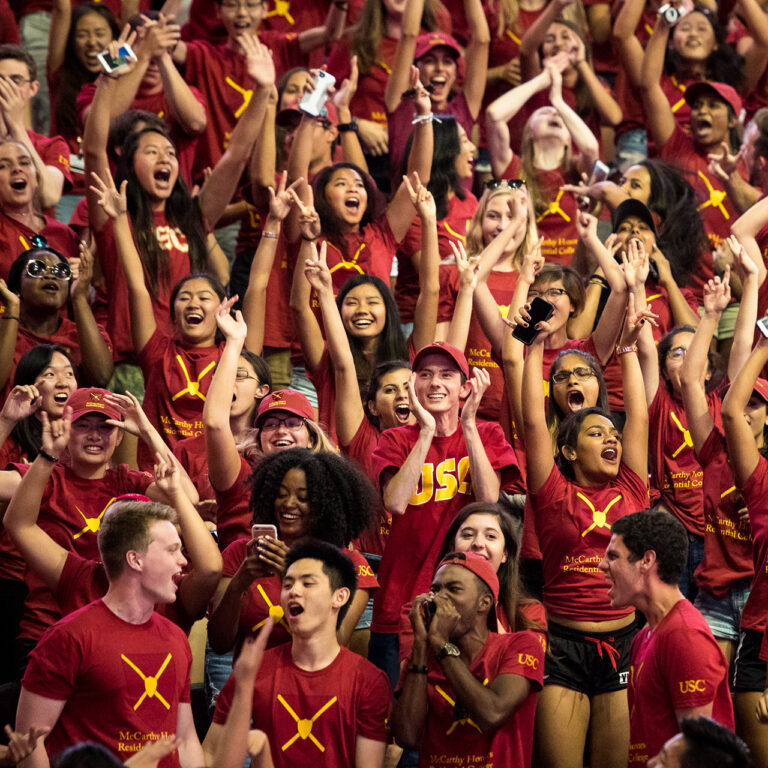2019
The Lord Foundation of California, which supports faculty research and teaching at USC, receives $260 million from the sale of LORD Corp. The foundation is expected to distribute proceeds to USC in 2020, making it USC’s largest-ever gift from a named donor. The gift would be used to bolster research and studies in areas including artificial intelligence, big data, analytics, and environmental sustainability.
2019
USC’s newest academic building, Iovine and Young Hall, officially opens. The 40,000-square foot, state-of-the-art facility includes a dedicated “incubator” space for Trojan alumni.
2018
The USC Marshall of School of Business announces that more than 50 percent of its full-time MBA Class of 2020 are women — this gender parity is a first for top-tier U.S. business schools.
2017
USC Dana and David Dornsife College of Letters, Arts and Sciences professor Viet Thanh Nguyen receives a MacArthur Foundation Fellowship.
2017
USC researchers provide key analysis of the data gathered annually by the county and city of Los Angeles, as part of the university’s Initiative to Eliminate Homelessness.
2017
An independent economic impact study on USC showed that the university is one of California’s strongest economic engines. The study found that USC spurs $8 billion annually in economic activity in the Los Angeles region and California.
2017
The Campaign for USC reached its $6 billion goal 18 months earlier than anticipated, securing its place among the most successful campaigns in higher education. The university extends its fundraising through 2021 to support high ambitions and access for students.
2016
USC alumni Oscar De Los Santos ’15 and Jung Kian Ng B.S., M.S. ME ’14 were among 32 Americans who were awarded a prestigious Rhodes Scholarship to the University of Oxford.
2016
USC Annenberg School for Communication and Journalism professor Josh Kun receives a MacArthur Foundation Fellowship.
2016
USC’s Neighborhood Academic Initiative celebrates 25 years of preparing low-income neighborhood students for admission to a college or university.
2016
For the first time ever, women outnumbered men in USC’s graduate video game design program – ranked #1 by Princeton Review for game design.
2015
Professor Dana Gioia was named California Poet Laureate by Governor Jerry Brown.
2015
The George Lucas Family Foundation endows the recruitment of USC Cinematic Arts students from communities underrepresented in the entertainment industry.
2015
A gift from Rick Caruso founds the USC Tina and Rick Caruso Department of Otolaryngology – Head and Neck Surgery to support advanced research for the field.
2015
In partnership with Los Angeles policymakers and educational institutions, USC lays out the strategic groundwork for the region’s biotechnology corridor.
2014
A gift from Ronnie Chan founds the USC Mrs. T.H. Chan Division of Occupational Science and Occupational Therapy, the first naming gift ever made in the field.
2014
The USC Men’s Tennis team won the university’s 100th national championship.
2013
The FDA approved the Argus II retinal prosthesis system, developed by University professor Mark Humayun and his team.
2013
Keck Medicine physicians become the first to implant the FDA-approved epilepsy-controlling device, the NeuroPace RNS.
2013
Campaign for USC reaches a milestone, raising $3 billion in a record-breaking 3 years.
2013
USC School of Cinematic Arts opens the new Interactive Media Building, showcasing video game design, transmedia, and world building projects.
2013
Campus health gets an upgrade as the five-story, 101,000-square-foot USC Engemann Student Health Center opens.
2012
In 2012, the university added its sixth arts school—The USC Glorya Kaufman School of Dance.
2011
USC Dana and David Dornsife College of Letters, Arts and Sciences professor Jacob Soll receives a MacArthur Foundation Fellowship.
2011
The School of Policy, Planning, and Development is renamed the USC Sol Price School of Public Policy with a $50 million gift from the Price Family Charitable Fund.
2011
With a transformative gift of $150 million from the
W. M. Keck Foundation, USC’s academic medical enterprise is named Keck Medicine of USC.
2011
USC receives $110 million from Julie and John Mork to create the Mork Family Scholars Program — USC’s largest single gift ever for undergraduate scholarships.
2011
The country’s largest public literary festival, the Los Angeles Times Festival of Books, finds a new home on USC’s University Park Campus.
2011
USC receives $200 million – the largest single gift in its history to date – from Dana and David Dornsife.
2011
Elizabeth Garrett is installed as USC’s first female provost.
2011
University Professor and historian Kevin Starr is inducted into the California Hall of Fame.
2010
USC becomes the first academic institution in the world to be designated an International Safe Community by the World Health Organization.
2010
C. L. Max Nikias becomes the 11th president of USC.
2010
The Institute of International Education’s annual Open Doors report names USC the country’s leader in international student enrollment for the ninth year in a row.
2010
USC opens its sixth international office (and fifth in Asia) in Seoul, South Korea.
